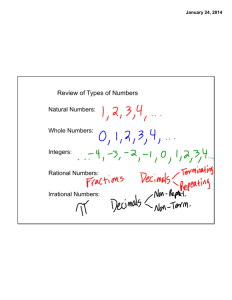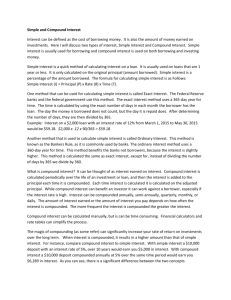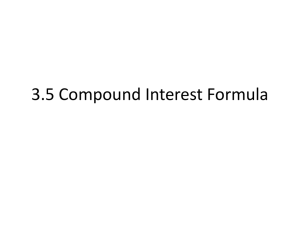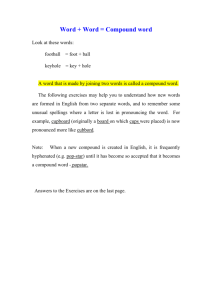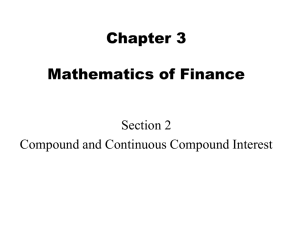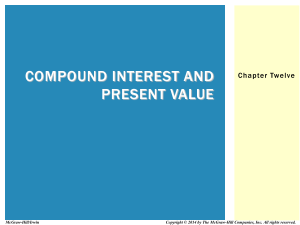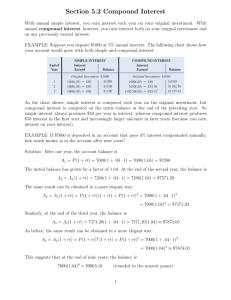Practice Exam 3 & Key – Survey of Math (Barry McQuarrie)
advertisement
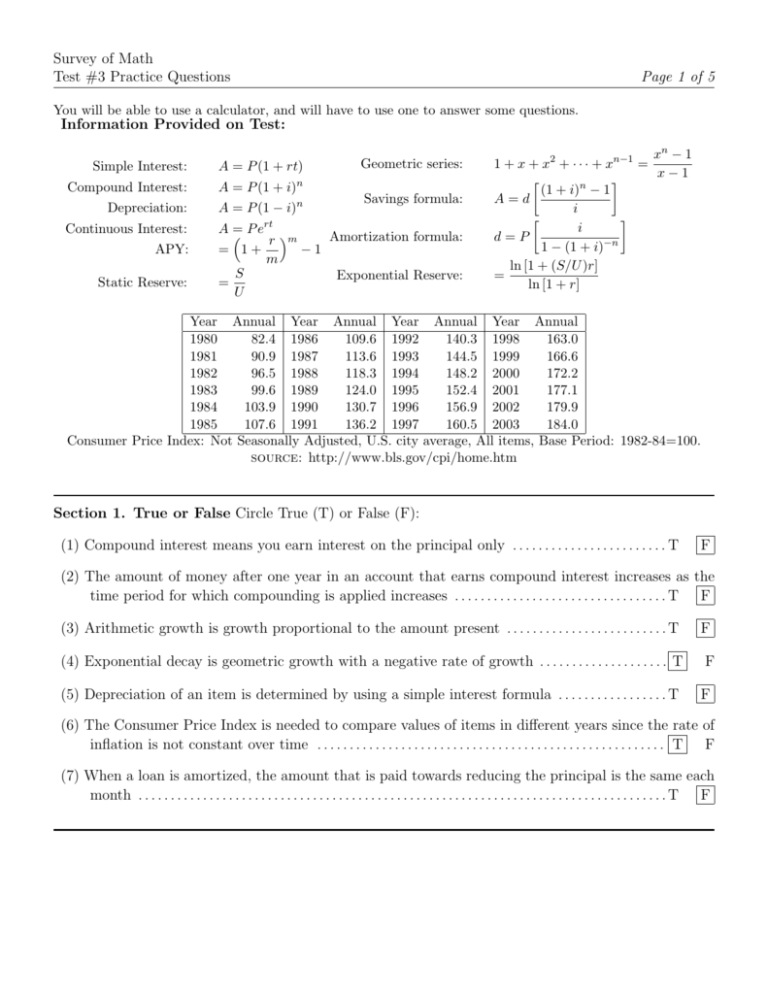
Survey of Math Test #3 Practice Questions Page 1 of 5 You will be able to use a calculator, and will have to use one to answer some questions. Information Provided on Test: Simple Interest: A = P (1 + rt) Compound Interest: A = P (1 + i)n Depreciation: A = P (1 − i)n Continuous Interest: APY: Static Reserve: Geometric series: Savings formula: rt A= P e r m Amortization formula: = 1+ −1 m S Exponential Reserve: = U xn − 1 1 + x + x2 + · · · + xn−1 = x−1 (1 + i)n − 1 A=d i i d=P 1 − (1 + i)−n ln [1 + (S/U )r] = ln [1 + r] Year Annual Year Annual Year Annual Year Annual 1980 82.4 1986 109.6 1992 140.3 1998 163.0 1981 90.9 1987 113.6 1993 144.5 1999 166.6 1982 96.5 1988 118.3 1994 148.2 2000 172.2 1983 99.6 1989 124.0 1995 152.4 2001 177.1 1984 103.9 1990 130.7 1996 156.9 2002 179.9 1985 107.6 1991 136.2 1997 160.5 2003 184.0 Consumer Price Index: Not Seasonally Adjusted, U.S. city average, All items, Base Period: 1982-84=100. source: http://www.bls.gov/cpi/home.htm Section 1. True or False Circle True (T) or False (F): (1) Compound interest means you earn interest on the principal only . . . . . . . . . . . . . . . . . . . . . . . . T F (2) The amount of money after one year in an account that earns compound interest increases as the time period for which compounding is applied increases . . . . . . . . . . . . . . . . . . . . . . . . . . . . . . . . . T F (3) Arithmetic growth is growth proportional to the amount present . . . . . . . . . . . . . . . . . . . . . . . . . T F (4) Exponential decay is geometric growth with a negative rate of growth . . . . . . . . . . . . . . . . . . . . T F (5) Depreciation of an item is determined by using a simple interest formula . . . . . . . . . . . . . . . . . T F (6) The Consumer Price Index is needed to compare values of items in different years since the rate of inflation is not constant over time . . . . . . . . . . . . . . . . . . . . . . . . . . . . . . . . . . . . . . . . . . . . . . . . . . . . . . T F (7) When a loan is amortized, the amount that is paid towards reducing the principal is the same each month . . . . . . . . . . . . . . . . . . . . . . . . . . . . . . . . . . . . . . . . . . . . . . . . . . . . . . . . . . . . . . . . . . . . . . . . . . . . . . . . . . T F Survey of Math Test #3 Practice Questions Page 2 of 5 Section 2. Multiple Choice Circle the most appropriate answer: (1) You have $2500 that you invest at 6% simple interest. What is the balance after four years? A) $310 B) $3000 C) $3100 D)$3156.19 (2) What is the Annual Percentage Yield (APY) for an annual rate of 5.3% compounded quarterly? A) 5.3% B) 5.4% C) 5.5% D) 5.6% (3) You have $2500 that you invest at 6% compound interest, compounded monthly. What is the balance after four years? A) $3000 B) $3100 C) $3156.19 D) $3176.22 (4) What is the Annual Percentage Yield (APY) for an annual rate of 6% compounded monthly? A) 0.500% B) 6.000% C) 6.090% D) 6.168% (5) The following graph represents the amount of money in a savings account, where there is an initial amount deposited of $100 and no more deposits made. The interest earned on the account is A) simple interest. B) compound interest compounded yearly. C) compound interest compounded monthly. D) there is not enough information given to answer the question. (6) Which of the following graphs could represent the accumulated balance on a bond which earns compound interest? A) B) C) D) Survey of Math Test #3 Practice Questions Page 3 of 5 (7) If the annual interest rate on a credit card is 6%, then the APR (annual percentage rate) is A) 6.00% B) 6.09% C) 6.18% D) 7.25% (8) A house cost $24,000 in 1987. What would the cost of the house be in 2003 dollars? A) $14,817.39 B) $40,787.24 C) $1,6896,000 D) $38,873.24 (9) The rule of 70 for population doubling says that a population that is growing at a constant rate of r% per year will double in size in B) 70/r years A) 70 years C) 70r years D) 70r years (10) For the following reproduction curve, the equilibrium population is A) 0 B) 1 C) 0.5 D) 2 E) There is no equilibrium F) Both A and B (11) For the logistic population model f (x) = 3x(1 − x), if the starting population fraction is 0.4, then the next population fraction is C) 0.720 D) −36 A) 0.116 B) 0.416 Section 3. Short Answer (1) The population of China in 2007 is 4.056 billion people. The population is expected to grow at a rate of 1.8% per year. Use the rule of 70 to estimate how long it will take for the population to double. 70 = 39 years. 1.8 (10) If the population begins at 1.5, draw a cobweb diagram on the following reproduction curve: Survey of Math Test #3 Practice Questions Page 4 of 5 (2) The population of China in 2007 is 4.056 billion people. The population is expected to grow at a rate of 1.8% per year. What will the population be in 2040? 4.056(1 + 0.018)2040−2007 = 4.056(1.018)33 = 7.3076 billion (3) A population of 100 exhibits arithmetic growth of 10 units per month. What is the population in after 1 year? 100 + 10 × 12 = 220 (4) A car depreciates at 15% per year and cost $25,000 in 2007. What will it’s value be in 2010? $25, 000(1 − 0.15)3 = $15, 353.10 Section 4. Long Answer (1) You purchase a home for $99, 000 with an annual interest rate of 6.375% and a 30 year mortgage. What are your monthly payments, and how much of the first monthly payment goes towards interest? First, we need to know how much the monthly payment is for this house. We can use the amortization formula to figure this out: 1 − (1 + i)−k d i 1 − (1 + 0.06375/12)−360 d (0.06375/12) d [160.29] $99, 000 = $617.631 160.29 P = $99, 000 = $99, 000 = d = Survey of Math Test #3 Practice Questions Page 5 of 5 The monthly payments are $617.63. The interest on the principal in the first month is Pi = P × r 0.06375 = $99, 000 × = $525.94 n 12 Therefore, $525.94 of the first monthly payment goes towards interest. The rest of the monthly payment reduces the principal. (2) Suppose that you have a bank account with a balance of $4532.10 at the beginning of the year and $4632.10 at the end of the year (you made no deposits to the account). What is the effective interest rate? The effective rate is the rate we would have to use for simple interest to get the amount over the same time frame. The amount of interest earned was $100.00, so the effective rate r satisfies A = P (1 + kr) $4632.10 = $4532.10(1 + r) where we set k = 1 for one year $4632.10 − 1 = 2.2065% r = $4532.10 Or you could get it from: r= $100 = 2.2065%. $4532.10


